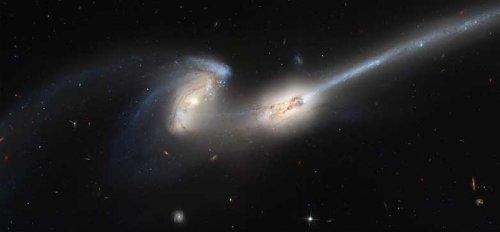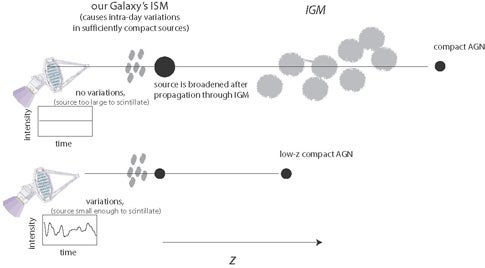An international team of astronomers may now have the first direct evidence for a turbulent, ionized intergalactic medium at redshift values of z>2. The research leading to this finding was done by Drs. Roopesh Ojha (U.S. Naval Observatory), Tapio Pursimo (Nordic Optical Telescope), David L. Jauncey and Jim E. Lovell (Australia Telescope National Facility), Jean-Pierre Macquart (National Radio Astronomy Observatory/Caltech) and Michael Dutka (University of Maryland), and was presented at the American Astronomical Society meeting in Seattle, Washington. This result is a first step towards being able to understand the possible inhomogeneity — “lumpiness” — of the intergalactic medium (IGM) at high redshifts, and to trace how the IGM has changed over time.
“This technique gives astronomers an important new tool for probing the ionized gas in the intergalactic medium”, says Dr. Ojha. “While current observational techniques are able to study the neutral gas at higher redshifts, we now have the ability to study the ionized gas which is postulated to be much more widespread than neutral gas at these redshifts. Thus we may have a new way to test current theories about the nature of the IGM.” The space between stars in a galaxy is not empty; think of it as a thin “soup” of gas and dust. Known as the interstellar medium (ISM), this soup is known to be both lumpy and turbulent, a sort of “cosmic minestrone”.
But now Ojha et al. have used the ISM &mdash the “minestrone” in our Galaxy — as a special kind of filter to distinguish between distant compact radio sources — quasars — on the basis of their angular size. And above a redshift of 2, the angular size of the sources appears to increase. Ojha et al. argue that this apparent increase in size is not due to the intrinsic nature of the sources or some trick of cosmology, but rather that it is the result of the quasars’ radio emission being scattered by a turbulent and ionized IGM.
How does one use the interstellar medium as a filter? In the 1980s, certain extragalactic radio sources, the quasars, were found to vary on extremely short time scales, their radio flux strength rising and falling drastically in just a few hours. After a bit of sleuthing, this “intraday variability” was traced to the ISM, which was causing the quasars to scintillate, or “twinkle”, just as Earth’s atmosphere causes stars to twinkle. Radio telescope sky surveys then followed to establish how widespread these rapidly scintillating sources were.
The largest of these surveys to date, MASIV (Micro-Arcsecond Scintillation-Induced Variability), was carried out using the National Science Foundation’s Very Large Array radio telescope at Socorro, New Mexico, by Jim Lovell and colleagues. MASIV detected 500 flat-spectrum radio sources at a frequency of 5 GHz: 56% of these showed scintillation. Ojha et al. obtained redshifts for 190 of the 500 sources in the MASIV survey: 150 came from the literature, while 40 were new measurements made with the 2.6-m Nordic Optical Telescope in La Palma, Spain. The entire dataset was then used to look for any difference in the redshift distribution of scintillating and non-scintillating sources. The researchers found, to a 98% confidence level, a redshift dependence on the scintillators, with a striking deficit of scintillating sources above z~2.
Scintillation occurs only if the radio sources are below a certain angular size, which is around 100 millionths of an arcsecond — a level of detail that would allow us to see an ant in Albuquerque, New Mexico while sitting in downtown Sydney, Australia! This is almost 10 times finer than the angular size that astronomers can currently observe by other techniques. The drop-off at z~2 implies that, at higher redshifts, the sources are either intrinsically or apparently larger in angular size. While an intrinsically larger angular size at higher redshifts cannot be completely ruled out, there are a number of reasons why this is not very likely. Current theories of galaxy formation tell us that quasars should appear smaller at higher redshifts. Also, the sources for the MASIV survey were selected in a manner that tended to bias the survey towards finding smaller sources at high redshifts.
The most likely explanation of these results is that an ionized IGM is diffusing the radio emissions from the quasars, causing them to appear larger than the angular size below which they can twinkle. A terrestrial analogy would be the way fog or heavy snowfall diffuses the headlights of distant oncoming cars at night. At z>2 the Universe was much smaller than it is today, so the intergalactic medium must have been much denser, overall, than it is now. Hot young stars, radio galaxies, and quasars, all present in abundance at this epoch, would have been “ionization factories” pumping out both ionizing radiation and charged particles. “We believe, therefore, that we’re seeing the effect of the radio signals being scattered by the ionized intergalactic medium,” said Dr. Jauncey. “But to confirm this result, we really need to get more redshifts, particularly for weaker sources, so that we can rule out any possible selection effects,” said Dr. Pursimo.
Given enough radio sources of the right kind, the scientists say, they might be able to trace how the scattering properties of the intergalactic medium changed through time at higher redshifts. The degree of inhomogeneity, or lumpiness, in the intergalactic medium could be established by taking optical spectra along the lines of sight to quasars from the survey.











